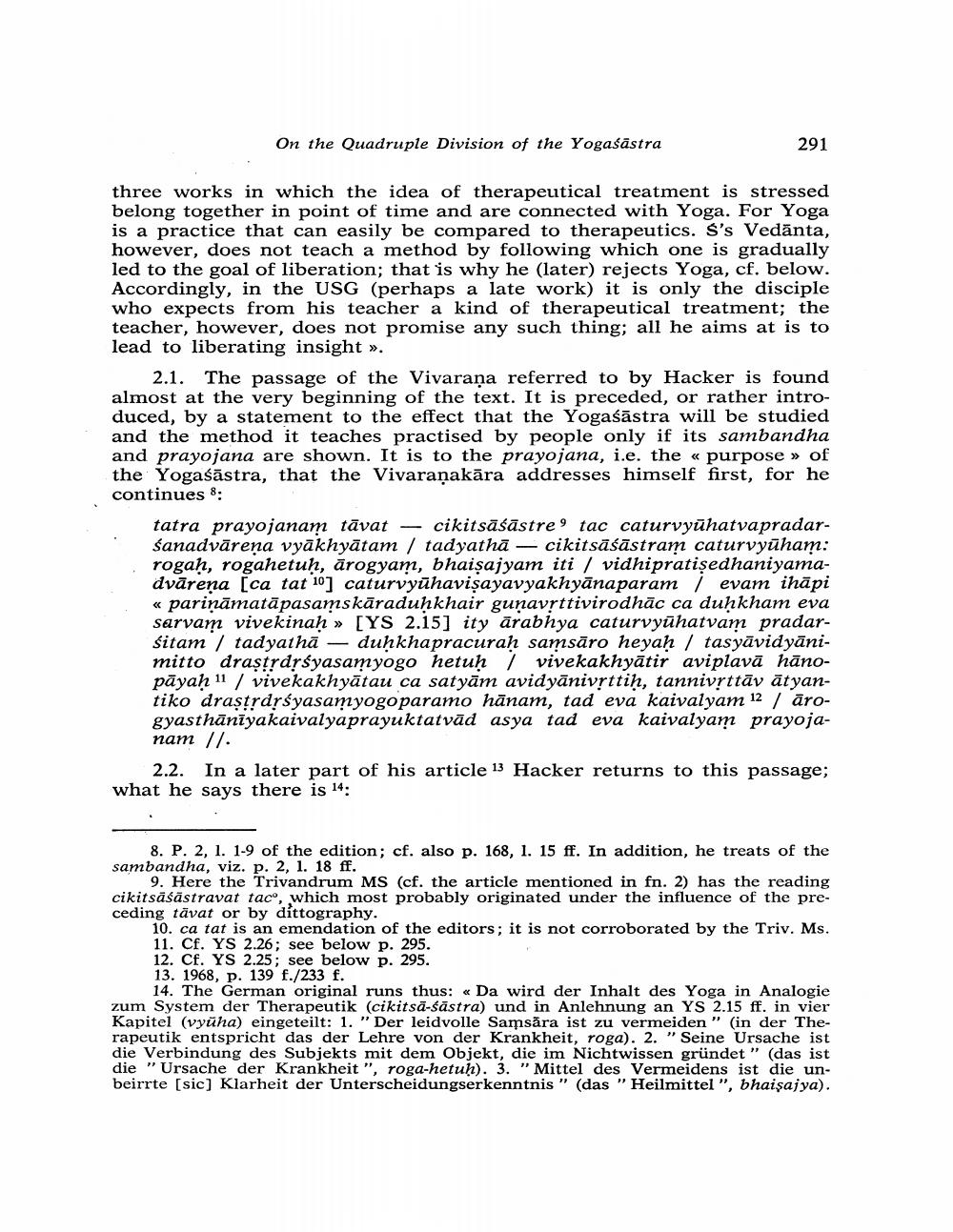Book Title: On Quadruple Division Of Yogasastra Author(s): A Wezler Publisher: A Wezler View full book textPage 3
________________ On the Quadruple Division of the Yogaśāstra 291 three works in which the idea of therapeutical treatment is stressed belong together in point of time and are connected with Yoga. For Yoga is a practice that can easily be compared to therapeutics. S's Vedānta, however, does not teach a method by following which one is gradually led to the goal of liberation; that is why he (later) rejects Yoga, cf. below. Accordingly, in the USG (perhaps a late work) it is only the disciple who expects from his teacher a kind of therapeutical treatment; the teacher, however, does not promise any such thing; all he aims at is to lead to liberating insight ». 2.1. The passage of the Vivarana referred to by Hacker is found almost at the very beginning of the text. It is preceded, or rather introduced, by a statement to the effect that the Yogaśāstra will be studied and the method it teaches practised by people only if its sambandha and prayojana are shown. It is to the prayojana, i.e. the « purpose of the Yogaśāstra, that the Vivaranakāra addresses himself first, for he continues 8: tatra prayojanam tāvat — cikitsāśāstre 9 tac caturvyūhatvapradarśanadvāreņa vyākhyātam / tadyathā — cikitsāśāstram caturvyūham: rogan, rogahetun, ārogyam, bhaisajyam iti / vidhipratişedhaniyamadvāreņa [ca tat 10] caturvyūhavişayavyakhyānaparam / evam ihāpi « pariņāmatāpasamskāraduḥkhair guņavrttivirodhāc ca duḥkham eva sarvam vivekinah » [YS 2.15] ity ārabhya caturvyūhatvam pradarśitam / tadyathā — duḥkhapracuraḥ samsāro heyah / tasyāvidyānimitto drastrdrśyasamyogo hetun / vivekakhyātir aviplavā hānopāyaḥ 11 / vivekakhyātau ca satyām avidyānivsttiḥ, tannivrttāv ātyantiko drastrdrśyasamyogoparamo hānam, tad eva kaivalyam 12 / ārogyasthānīyakaivalyaprayuktatvād asya tad eva kaivalyam prayojanam //. 2.2. In a later part of his article 13 Hacker returns to this passage; what he says there is 14: 8. P. 2, 1. 1-9 of the edition; cf. also p. 168, 1. 15 ff. In addition, he treats of the sambandha, viz. p. 2, 1. 18 ff. 9. Here the Trivandrum MS (cf. the article mentioned in fn. 2) has the reading cikitsäsästravat taco, which most probably originated under the influence of the preceding tăvat or by díttography. 10. ca tat is an emendation of the editors; it is not corroborated by the Triv. Ms. 11. Cf. YS 2.26; see below p. 295. 12. Cf. YS 2.25; see below p. 295. 13. 1968, p. 139 f./233 f. 14. The German original runs thus: «Da wird der Inhalt des Yoga in Analogie zum System der Therapeutik (cikitsa-śāstra) und in Anlehnung an YS 2.15 ff. in vier Kapitel (vyuha) eingeteilt: 1. "Der leidvolle Samsāra ist zu vermeiden " (in der Therapeutik entspricht das der Lehre von der Krankheit, roga). 2. "Seine Ursache ist die Verbindung des Subjekts mit dem Objekt, die im Nichtwissen gründet" (das ist die "Ursache der Krankheit", roga-hetuh). 3. "Mittel des Vermeidens ist die unbeirrte (sic) Klarheit der Unterscheidungserkenntnis" (das "Heilmittel ", bhaisajya).Page Navigation
1 2 3 4 5 6 7 8 9 10 11 12 13 14 15 16 17 18 19 20 21 22 23 24 25 26 27 28 29 30 31 32 ... 49
